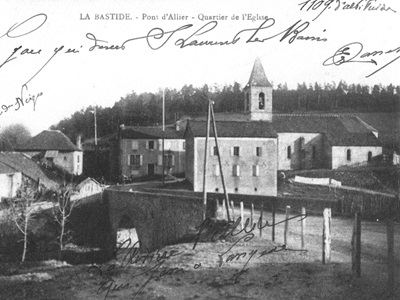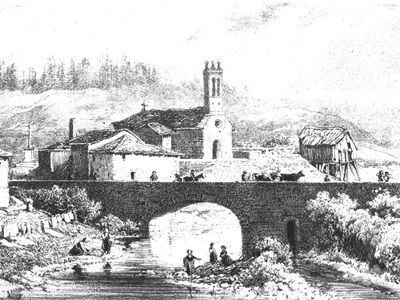

|
The history of La Bastide-Puylaurent in Lozère (Occitanie). Hiking trails: GR®70 Stevenson trail, GR®7, GR®72, GR®470 Gorges of the Allier, GR®700 Regordane Way or St Gilles trail, GRP Le Cevenol, Tour of Ardechoise Mountains and Margeride. |

 La Bastide-Puylaurent, a name that evokes both the gentleness and ruggedness of the mountains, the charm and history of a village. A village that hasn’t always borne this name or occupied the same location.
La Bastide-Puylaurent, a name that evokes both the gentleness and ruggedness of the mountains, the charm and history of a village. A village that hasn’t always borne this name or occupied the same location.
During the time of the French Revolution, it was Puylaurent that served as the capital of the commune—a hamlet perched on the heights, overlooking the Allier Valley. However, in 1917, the village’s destiny shifted when the President of the Republic signed a decree transferring the town hall to the hamlet of La Bastide, situated lower down by the river. This marked the beginning of a new era for the commune, which adopted its current name.
But to truly understand the history of La Bastide-Puylaurent, we must go even further back, to the early 16th century. At that time, La Bastide was merely a modest village with seven or eight houses, built on the right bank of the Allier River. On the other side of the bridge, across the left bank, lay the Gévaudan, a wild and mysterious land where the Bastide family resided. They owned a farm called Trouillas. Some claimed that it was they who bestowed their name upon the village, but certainty eluded everyone
 Further beyond the Rieufret stream lay the Vivarais, a more cheerful and fertile region where beautiful residences stood. Among them were the Barrial, Valentins, Bresson, Astruc, Rieu, Hébrard, and Chambonnet families—the oldest and most respected families in the village. For generations, they shared the lands and herds. This is how the village appeared in the 1609 land registers, where the rights and duties of the inhabitants toward their lords were recorded. It remained nearly unchanged, except for a few new constructions, until the 1810 cadastral plan, which defined the boundaries and names of the parcels.
Further beyond the Rieufret stream lay the Vivarais, a more cheerful and fertile region where beautiful residences stood. Among them were the Barrial, Valentins, Bresson, Astruc, Rieu, Hébrard, and Chambonnet families—the oldest and most respected families in the village. For generations, they shared the lands and herds. This is how the village appeared in the 1609 land registers, where the rights and duties of the inhabitants toward their lords were recorded. It remained nearly unchanged, except for a few new constructions, until the 1810 cadastral plan, which defined the boundaries and names of the parcels.
However, La Bastide was not isolated from the world. It was traversed by an ancient Roman road called the Régordane, connecting Saint-Gilles in Gard to Puy-en-Velay in Haute-Loire. This road was frequented by pilgrims, traders, and transhumant herders who stopped at the inns of La Bastide to rest and refresh. At that time, La Bastide fell under the jurisdiction of the parish of Chasserades, where the church and cemetery were located.
 Around La Bastide, there were other hamlets and farms scattered in the valleys of the Allier and Rieufret. Among them were Les Huttes, where the Barrel and Ranc families lived, La Courège, Les Bories, Compan, and La Felgère, which were considered substantial houses. There was also Malataverne, a hamlet with two houses that has since disappeared. All these places had their own histories, secrets, and legends.
Around La Bastide, there were other hamlets and farms scattered in the valleys of the Allier and Rieufret. Among them were Les Huttes, where the Barrel and Ranc families lived, La Courège, Les Bories, Compan, and La Felgère, which were considered substantial houses. There was also Malataverne, a hamlet with two houses that has since disappeared. All these places had their own histories, secrets, and legends.
And then there was Saint-Thomas de la Souche, a priory founded by the monks of Tornac near Anduze. These monks owned large herds that would ascend to the Gévaudan during the summer. The priory served as a place of prayer and rest, situated near a spring that flowed alongside the Régordane. Unfortunately, nothing remains of this priory except for a rustic cross, facing the current cemetery.
 In 1728, Abbé Robert, the parish priest of Puylaurent, visited the ruins of an ancient chapel and a hospital founded during the Middle Ages by monks from the Tornac order. There, he discovered traces of a forgotten past—a time when the religious welcomed and cared for travelers, shepherds, muleteers, and transhumant herders who traversed the rugged paths of the region. He also observed the remnants of a cemetery, where the departed had found their final refuge. With meticulous attention, he recorded the dimensions of the buildings and the land, as well as the income enjoyed by the monks from donations, tithes, and surrounding lands.
In 1728, Abbé Robert, the parish priest of Puylaurent, visited the ruins of an ancient chapel and a hospital founded during the Middle Ages by monks from the Tornac order. There, he discovered traces of a forgotten past—a time when the religious welcomed and cared for travelers, shepherds, muleteers, and transhumant herders who traversed the rugged paths of the region. He also observed the remnants of a cemetery, where the departed had found their final refuge. With meticulous attention, he recorded the dimensions of the buildings and the land, as well as the income enjoyed by the monks from donations, tithes, and surrounding lands.
The chapel and the hospital were inseparable, each justifying the other. Notarial deeds attested to their dual purpose—both spiritual and temporal. Sometimes only the chapel was mentioned, other times both, and occasionally even the priory and the hospital. But what did the term "hospital" truly signify? It could be translated as lodging, shelter, or inn, but that would diminish the monks' work. Indeed, the prior of the chapel and the hospital always served as the infirmarian of the Tornac monastery. This implied an organized system of care, even if it was basic or temporary. The hospital still existed in 1636, and the Tornac infirmarian held official responsibility for it.
 More than a hundred and fifty years later, La Bastide-Puylaurent became the stage for a dramatic episode during the French Revolution: the conspiracy of Count de Saillans. This nobleman, originally from Dauphiné, devised a daring plan to overthrow the republican regime and restore the monarchy. His vision was to incite rebellion across the entire south of France, from the Pyrenees to the Rhône, forming a vast army supported by the Spanish and emigrants. He hoped to join forces with the royalists in Vendée, Brittany, and the Rhine.
More than a hundred and fifty years later, La Bastide-Puylaurent became the stage for a dramatic episode during the French Revolution: the conspiracy of Count de Saillans. This nobleman, originally from Dauphiné, devised a daring plan to overthrow the republican regime and restore the monarchy. His vision was to incite rebellion across the entire south of France, from the Pyrenees to the Rhône, forming a vast army supported by the Spanish and emigrants. He hoped to join forces with the royalists in Vendée, Brittany, and the Rhine.
On May 19, 1792, he arrived in La Bastide, at Pierre Combe's inn, where he met with members of the royalist committee from Jalès. Among them were Abbé Claude Allier, prior of Chambonas, and Joseph-Marie Chabalier, a resident of Puylaurent. They pledged their support and allegiance to his cause.
In early June, the revolt erupted. The royalists attacked the castle of Bannes, where a republican garrison was stationed, and massacred several National Guards in the village of Berrias. However, these acts of violence only drew the attention of the authorities, who dispatched troops to suppress the insurrection. The royalists were pushed back from several towns and villages, soon divided by internal dissensions. Abbé Allier and Count de Saillans engaged in heated disputes, each accusing the other of betrayal.
On July 8, the republicans forced the surrender of the castle of Bannes after a siege lasting several days. Then, on July 12, they achieved a decisive victory in the battle of Jalès, where Count de Saillans lost his life. The conspiracy was over, along with the hopes of the royalists in La Bastide-Puylaurent.
***
 In 1940, as war raged in Europe, the Polish Red Cross established a reception center for Polish refugees in La Bastide-Puylaurent, a small village in Lozère located between the sources of the Allier and the Chassezac river. The center was set up in two hotels, the Terminus and the Pins, which offered refuge and comfort to exiles fleeing the Nazi and Soviet occupation of their country.
In 1940, as war raged in Europe, the Polish Red Cross established a reception center for Polish refugees in La Bastide-Puylaurent, a small village in Lozère located between the sources of the Allier and the Chassezac river. The center was set up in two hotels, the Terminus and the Pins, which offered refuge and comfort to exiles fleeing the Nazi and Soviet occupation of their country.
The center welcomed men, women, and children of all ages and conditions. Some were wounded or demobilized soldiers, others were persecuted or deported civilians. All had experienced fear, hunger, suffering, and separation. At the center, they found some human warmth, solidarity, and hope. They received medical care, food, clothing, and education. They also participated in cultural, sports, and religious activities. They formed a close-knit community proud of its roots.
The center was run by Zbiggniev Malinoowki, a former officer of the Polish army, who devoted himself body and soul to the cause of his compatriots. He was assisted by French and Polish volunteers, who showed courage and generosity. The center was supported by local authorities, who respected and protected the refugees. The center was also in contact with the Polish resistance, which fought against the invader.
But the center was not safe from dangers. In 1942, the Vichy police issued an arrest warrant against Malinoowki, whom they accused of being a "dangerous terrorist". The director of the center managed to escape the hunt, but he had to hide and often change places. In 1944, German troops invaded the free zone and occupied La Bastide-Puylaurent. They arrested 25 Polish refugees, whom they considered enemies and undesirables. They were forcibly sent to Paris, then to Königsberg, in East Prussia, where they were exploited as slaves.
The Polish reception center in La Bastide-Puylaurent is a poignant testimony to the history of the Second World War, but also to the fraternity between peoples. It illustrates the tragic and heroic fate of the Poles, who fought for their freedom and dignity.
Old romantic Hotel, L'Etoile Guest-House is a mountain retreat in the South of France. With a beautiful park along the Allier River, L'Etoile Guesthouse is located in La Bastide-Puylaurent between Lozere, Ardeche and Cevennes. Hiking trails: GR®70 Stevenson trail, GR®700 Regordane way (St Gilles trail), GR®7, GR®72, GR®470 Allier river trail. Hiking loops: Cevenol, Ardechoise, Margeride. The right place to relax.
Copyright©gr-infos.com